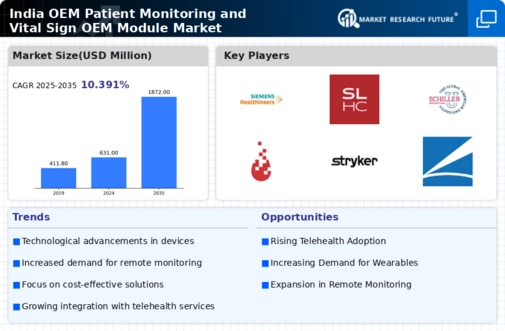Growing Aging Population
India's demographic shift towards an aging population is significantly influencing the oem patient-monitoring-vital-sign-oem-module market. By 2025, it is estimated that over 140 million individuals in India will be aged 60 and above, necessitating enhanced healthcare services. This demographic trend creates a heightened demand for patient monitoring solutions that can effectively track vital signs and manage chronic conditions prevalent among older adults. As healthcare providers strive to cater to this growing segment, the oem patient-monitoring-vital-sign-oem-module market is poised for expansion, driven by the need for reliable and efficient monitoring systems that can support the health of the elderly.
Increasing Healthcare Expenditure
The rise in healthcare expenditure in India is a pivotal driver for the oem patient-monitoring-vital-sign-oem-module market. As the government and private sectors allocate more funds towards healthcare, the demand for advanced monitoring solutions is likely to increase. In 2025, healthcare spending in India is projected to reach approximately $370 billion, reflecting a growth rate of around 12% annually. This financial commitment facilitates the adoption of innovative technologies, including patient monitoring systems, which are essential for improving patient outcomes. Consequently, manufacturers of oem patient-monitoring-vital-sign-oem-modules may find a more favorable environment for growth as hospitals and clinics seek to enhance their capabilities and efficiency.
Rising Incidence of Chronic Diseases
The increasing prevalence of chronic diseases in India is a significant factor driving the oem patient-monitoring-vital-sign-oem-module market. Conditions such as diabetes, hypertension, and cardiovascular diseases are on the rise, affecting millions of individuals. By 2025, it is anticipated that chronic diseases will account for over 60% of total healthcare expenditures in India. This trend necessitates continuous monitoring of patients' vital signs to manage these conditions effectively. Consequently, healthcare providers are likely to invest in advanced monitoring solutions, thereby propelling the growth of the oem patient-monitoring-vital-sign-oem-module market. The need for timely interventions and personalized care further underscores the importance of these monitoring systems.
Technological Integration in Healthcare
The integration of advanced technologies in healthcare is a crucial driver for the oem patient-monitoring-vital-sign-oem-module market. Innovations such as artificial intelligence, machine learning, and IoT are transforming patient monitoring systems, making them more efficient and user-friendly. In India, the adoption of these technologies is accelerating, with a projected market growth of 25% in the health tech sector by 2025. This technological evolution not only enhances the functionality of monitoring devices but also improves data accuracy and patient engagement. As healthcare facilities increasingly adopt these technologies, the demand for sophisticated oem patient-monitoring-vital-sign-oem-modules is expected to rise, reflecting a shift towards more connected and intelligent healthcare solutions.
Government Initiatives for Health Technology
Government initiatives aimed at enhancing health technology infrastructure are playing a vital role in the growth of the oem patient-monitoring-vital-sign-oem-module market. Programs such as the National Digital Health Mission are designed to promote the adoption of digital health solutions across the country. By 2025, the Indian government is expected to invest significantly in health technology, with a focus on improving access to quality healthcare. This investment is likely to create a conducive environment for the development and deployment of advanced patient monitoring systems. As healthcare facilities align with government policies and funding, the demand for oem patient-monitoring-vital-sign-oem-modules is anticipated to increase, reflecting a broader commitment to enhancing healthcare delivery.























Leave a Comment